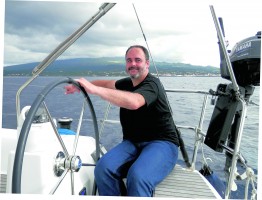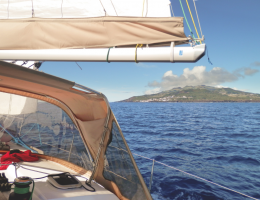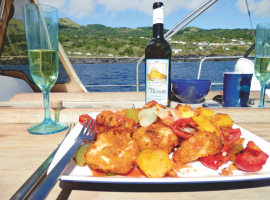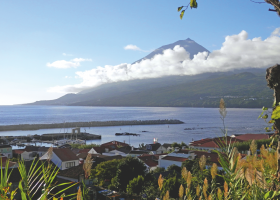New harbours, marinas and breakwaters have vastly increased the scope and potential of the Azores for a coast-hopping cruise. Kieran Flatt checks it out
I’ve wanted to cruise the Azores since childhood. Not to make a brief pitstop at Horta or Ponta Delgada on an eastbound transatlantic passage, as thousands of sailors do every year, but to potter at my own leisurely pace around these intriguing isles marooned on the mid-Atlantic ridge, exploring its intimate nooks and crannies, which very few people seem to do. I’ve often wondered why.
It was Joshua Slocum’s terse account of his own brief visit in 1895 that piqued my interest: ‘Only those who have seen the Azores from the deck of a vessel realize the beauty of the mid-ocean picture,’ he wrote in Sailing Alone Around the World.
Flicking through an illustrated atlas in a school library, I pictured myself helming a yacht along the broad, mile-deep channels between these lonely volcanic islands, making long, lazy tacks between the emerald green flanks of their saw-toothed ridges and soaring peaks.
The locals seemed friendly, too: of all the people Slocum encountered on his travels, he’d ‘met none anywhere kinder than the good hearts of this place’.
Last October, a quarter of a century later, I was lounging in the cockpit of a 38ft yacht with my wife Rachel at the wheel, pointing our bows at the distant silhouette of São Jorge while the coast of Pico slipped past to starboard and the sun began to set behind the hulking mass of Faial astern. Here I was, fulfilling one of my longest-held ambitions – but my conscience was telling me I’d cheated.
A unique landfall
A couple of things combine to give the Azores a powerful allure. It’s partly the historical interest of a place that has played a pivotal role in six centuries of seafaring. Where else can you moor up where Spanish galleons once lay laden with treasure, surrounded by architecture that Columbus himself would have recognised?
It’s also the islands’ sheer distance from anywhere else. To cruise the Azores, you first have to cross at least 800 miles of empty ocean. From Falmouth it’s about 1,200 miles, most likely hard on the wind for several weeks. To arrive here, in essence, means you’ve become a true blue water sailor.
Not in my case, though. I’d merely hopped on a plane from Heathrow and plopped down on the tarmac with a gaggle of package tourists. I’d felt a bit of a fraud that afternoon in Horta’s famous sailors’ bar, Peter’s Café Sport, chatting to folks who’d crossed oceans to get here. But now, powering up the Canal de Horta under a magnificent spread of sail, my nagging conscience evaporated.
There is, of course, a good reason why most visiting crews tend to hunker down in a safe harbour and venture no further. The Azores’ topography, alas, doesn’t lend itself to anchoring. Many bays look inviting, but poor holding among basalt boulders on a 45° slope is the best you can hope for in most places. There are small, pretty harbours where a yacht can anchor, but they provide only partial shelter, swell is rarely absent and holding is uncertain.
Suddenly, a lot has happened to broaden the appeal and scope of the Azores as a cruising ground. Thanks in part to EU funding, new yacht berthing facilities are now in place on most of the islands. Where once were rolly roadsteads, mostly wide open to the east, all-weather marinas now nestle behind stout new breakwaters. What’s more, they’ve managed to build them without ruining the landscape. Last year, a couple of local chaps saw the potential for coast-hopping cruises and set up the islands’ first bareboat charter business. I had five days to check it all out.
The trip hadn’t started auspiciously, though. Two hours after we’d touched down on Faial, Rachel and I were still staring forlornly at an empty baggage carousel, waiting for confirmation that our bags were indeed lost and might not turn up for two or three days. Halfway to Horta, as the taxi hurtled through a landscape of drystone walls, blue hydrangeas and improbably green pastures, it dawned on me that this was more than an inconvenience.
The weather forecast was fair for three days, then assuredly foul – we couldn’t afford to wait for our sailing kit to turn up. Nor could we put to sea in our city clothes, she in a smart summer dress, me in a faintly ridiculous linen suit. But it was a Sunday, Monday was a bank holiday. The shops would all be shut.
The charter boss, Nicolau Faria, had a solution. After a quick pep talk over lunch and a whirlwind tour of his Dufour 375 we were whisked off in his wife’s cigarette delivery van, clattering through cobbled streets, out of town to a retail park where a lone supermarket and a nasty-looking leisurewear shop thumbed their noses at the Sabbath.
‘You must leave today, or you won’t be able to go anywhere,’ said Nicolau. ‘You should at least go to Velas.’ He was right, and it was already 4pm, I foolishly tried to cajole my wife into buying a week’s worth of clothes that she didn’t like and didn’t quite fit her – and to do it in all in half an hour. Somehow, by 1700 we were back aboard, ramming provisions into lockers, and ten minutes later we were off.
‘Why are the compasses pointing in different directions?’ I asked as Nicolau cast off our warps. ‘Don’t trust them,’ he replied. ‘Just drive the boat on the plotter.’ I glanced in horror at the big screen and small, unlabelled buttons. Rachel took charge, fired up the plotter and in less than a minute had us on course for Velas. ‘It’ll be dark before we get there,’ she warned.
She was right. Twilight turned to night as we closed the coast of São Jorge. Now I really wanted a working compass, not to mention binoculars to make sense of the cluster of twinkling lights ahead. Vila de Velas means town of candles – I hoped the harbour was well lit.
Dark shapes fluttered aloft: squadrons of Cory’s shearwaters overtaking us at an effortless 30 knots, headed for their roost overlooking the harbour. It was pitch dark when we arrived and I added a torch to my wish list. The marina was invisible until we were right on it, tucked under a brooding escarpment blotting out half the sky.
We tied up alongside a handy hammerhead pontoon and slumped in our bunks, listening to the strange cacophony of the shearwaters on the cliffs, like a legion of lapdogs trying to bark through kazoos.
A bright blue dawn showed Velas in a different light – what a view from the cockpit! Ahead, the whitewashed buildings of the old town straggled up the hillside, topped off with a 16th century church spire.
To port, a cliff of leafy shrubs rose sheer from the quay to a vanishing point far above us. To starboard, the mile-and- a-half high cone of Pico loomed over the breakwater. A good sailing breeze was beginning to blow but we had to stay put until our luggage turned up, so we donned our ill-fitting new leisurewear and strolled through the impressive 18th century portal on the quay to explore the town and soak up its laid-back vibe.
Pico, eight miles away, contrived to thrust its great cone into most of our photos. ‘Wherever you are on this island, the mountain is always looking over your shoulder,’ as a shopkeeper eloquently put it.
Back in the marina that evening, waiting for the ferry from Horta to dock – with, we hoped, our luggage aboard – we spent a pleasant few hours in the cockpit of our French neighbours, who had coast-hopped from Brittany to Portugal before striking out on a beam reach for the Azores, where they planned to base her for a year, flying out for holidays. ‘It’s strange that we’ve seen so few British yachts cruising the islands,’ they said.
Reunited with our own charts, binoculars, lifejackets, torch, sailing knives, oilskins and hand-bearing compass, we set off early the next morning, tacking across the eight-mile wide channel between the stegosaurus ridge of São Jorge and the soaring volcano of Pico, scanning the sea for sperm whales, which are allegedly abundant in these waters, but saw only a distant blow.
I abandoned the plan to stop briefly at two smaller harbours, Sao Roque do Pico and Calheta on São Jorge, as they were wide open to the easterly swell.
We’d long since given up hope of meeting the local sea mammals when, rounding Pico’s eastern rump, a bullgrampus came scalloping through the waves to check us out, followed by two smaller consorts that we took to be a female and her calf. Venturing as close as we dared to the old whaling port of Calheta do Nesquim, we wondered how the heck they used to launch whole fleets of whaleboats from this swell-washed slipway encircled by fangs of rock.
We wallowed on, chasing the catspaws of a dying breeze and watching the stupendous mountain on our starboard side create its own weather. A mobile phone call from Nicolau confirmed that the clouds we could see forming were causing heavy rain at his home on the other side. After dipping into another intriguing little harbour, Ribeiras – again, wide open to theeast, but with less swell hooking in – we rounded the rocky lump of Ponta Queimada to see our destination, Lajes do Pico, ranged along the foreshore behind a wicked array of reefs churning the swell into a lather.
Lajes, formerly the Azores’ principal whaling port and now, ironically, their main whale-watching resort, lies in a shallow lagoon which, until a couple of years ago, was only accessible to boats drawing less than a metre, via a tortuous and scantily marked route through the rocks that required local knowledge. Now, a straight, well-buoyed fairway has been hewn through the reefs, with ample depth for most yachts above half tide, and you’ll find about 2.5m in the harbour, alongside the newly installed finger pontoons. The new breakwater quells the old fear of getting trapped here in heavy weather, when moored boats were regularly wrecked by breakers that swept over the reefs and occasionally washed along the main street. Ashore, the main attraction is a brilliant museum that documents the lives of the town’s whalers and showcases the tiny boats and hand-held harpoons with which they used to hunt the biggest animals on the planet.
Flying saucer cloud
Wednesday dawned with a grim, grey sky and a grimmer forecast. The foul weather they’d been promising for the remainder of the week was now gathering pace, and expected to arrive in just 18 hours. This was no mere squall, but the tail of a Cape Verde hurricane that had lashed the Azores viciously a few days before we arrived, howled off towards America then doubled back to wreak a bit more havoc. If we were going back to Horta, 20 miles west, we’d have to leave as soon as the tide allowed our 1.9m draught to clear the shallow patches in the channel.
Two hours later, Rachel noticed something odd as we turned north up the Canal do Horta, running before a fitful breeze, rolling uncomfortably on a nasty, chaotic lop. ‘That’s a strange-looking cloud,’ she said, pointing at Pico. ‘It looks like a flying saucer.’ It was an ill omen: a huge, angry lenticular cloudhung over the volcano’s peak. I recalled a photo of a similar cloud in an old Yachting Monthly article, with a caption explaining it was a sign of heavy weather to come. Our cloud was twice as big. The wind had died, but we needed to reef, pronto.
Too late. The wind hit as I reached for the halyard and within a few minutes we were running before half a gale, making upwards of 11 knots.
The flying saucer cloud launched itself off the mountain top and loomed towards us, leaving an extraordinary zigzag trail in its wake. A big sea was building astern, blessed relief at first from the infernal wallowing of the last few hours, but the south-going current was soon rucking it up into overfalls.
I didn’t fancy turning into them to get the mainsail down, so I turned my attention to the genoa. It was stuck, its furling line wrapped around a foredeck cleat. The wind was now gale force and 14 knots as we surfed down the wave fronts, the log touching 14 knots. The autopilot didn’t like it, so I took the helm. Only 10 minutes to Horta at this rate, if we could just hang on…
A sudden broach brought me to my senses. We had too much sail up and were losing control. Rachel wrestled the wheel as I
edged along the foredeck to sort out the tangle, sluiced with sheets of spray.
Job done, jib furled, the boat back under control but still making 12 knots, we barrelled through the gap between the breakwaters, rounded up, dropped the main and all was calm. Approaching the yacht basin, I realised we had a problem. Anxious crews preparing for the storm had rigged a cat’s cradle of kedge warps and mooring lines, which crisscrossed the fairway under water – at about the same depth as our saildrive prop. A lot of shouting got half a dozen skippers on deck, the lines were eased and we slipped through.
Nicolau was on the pontoon to take our lines, relieved to see his boat back in one piece.
‘We were watching you with binoculars when the storm hit,’ he said. ‘That was great seamanship out there.’ It certainly wasn’t, and we both knew it, but that hardly seemed to matter. We were soon ensconced in Café Sport once more – but this time we had a decent story to tell.
Six months later, I’ve still got that yearning to sail my own boat to the Azores. Knowing what’s there only strengthens the allure.
How to sail to the Azores from the UK
 The direct route from the British Isles is at least 1,200 miles, into prevailing southwesterlies. There’s a broad consensus that it’s best to set off between May and September, the first priority to get off soundings, clear of the turbulent seas and fishing fleets on the edge of the Continental Shelf. After that, opinions differ.
The direct route from the British Isles is at least 1,200 miles, into prevailing southwesterlies. There’s a broad consensus that it’s best to set off between May and September, the first priority to get off soundings, clear of the turbulent seas and fishing fleets on the edge of the Continental Shelf. After that, opinions differ.
Ann Hammick, who edits the excellent Atlantic Islands pilot book, advises sticking as close as practical to the straight-line route. Author Roger Taylor suggests keeping a little south and east of the rhumb line for the first half of the passage, in the hope of hitching a ride on the northerly breeze that often blows across the mouth of Biscay in the summer. Others break the passage in north- west Spain, or coast-hop from north Brittany to southern Portugal.
The return passage, typically between May and August, should be mainly a downwind ride. Many strike out north for the first third, to pick up favourable winds and currents, before turning for home.











